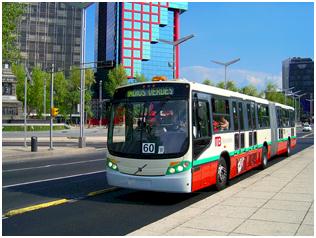 TRANSPORTATION IN MEXICO CITY
TRANSPORTATION IN MEXICO CITY
Mexico City is served by the Sistema de Transporte Colectivo Metro, an extensive metro system (207 km), which is the largest in Latin America. The first portions were opened in 1969 and now the system has 11 lines with 175 stations. In 2008 it was announced that a twelfth line will be constructed along with a suburban rail system similar to the French RER system.

The metro is one of the busiest in the world transporting approximately 4.5 million people every day, surpassed only by Moscow's (7.5 million), Tokyo's (5.9 million), and New York City's (5.1 million). It is heavily subsidized, and has the lowest fares in the world, and taking each passenger to almost any place in this enormous city from 05:00 am to 00:00 h.).
Several stations display Pre-Columbian artifacts and architecture that were discovered during the metro's construction. However, the Metro does not extend outside the limits of the Federal District and, therefore, an extensive network of bus routes has been implemented. These are mostly managed by private companies which are allowed to operate buses as long as they adhere to certain minimal service quality standards.
The city government also operates a network of large buses, in contrast with the privately operated microbuses, with fares barely exceeding that of the metro. Electric transport other than the metro also exists, in the form of trolleybuses and the Xochimilco Light Rail line. The city's first bus rapid transit line, the Metrobús, began operations on June 2005 in Avenida Insurgentes (a second line is under construction on Eje 4 Sur). As the microbuses were removed from its route, it was hoped that the Metrobús could reduce pollution and decrease transit time for passengers. Also, since late 2002, the white and green taxis have been joined by red and white ones as part of a program to replace older vehicles with new ones.
Mexico City is served by Mexico City International Airport (IATA Airport Code: MEX). This airport is the largest in Latin America in traffic, transporting nearly 25 million passengers per year. This traffic exceeds the capacity of the airport, which had historically centralized the majority of air traffic. The government has recently engaged in an extensive restructuring that includes the building of a second adjacent terminal and the enlargement of four other airports (at the nearby cities of Toluca, Querétaro, Puebla and Cuernavaca) that, along with Mexico City's airport, comprise the Grupo Aeroportuario de la Ciudad de México, distributing traffic to different regions in Mexico. Mexico City's airport is the main hub for 10 of the 12 national airline companies.
The city has four major bus stations (North, South, Observatorio, TAPO), with bus service to many cities across the country, and one train station, used for commercial and industrial purposes (interestate passenger trains are now virtually non-existent in Mexico). It was recently announced that a Tren Suburbano (suburban rail) will be built to serve the metropolitan area. There are also several toll expressways which connect Mexico City with several other major cities.
In the late 70's many arterial roads were redesigned as ejes viales; high-volume one-way roads that cross, in theory, Mexico City proper from side to side. The eje vial network is based on a quasi-Cartesian grid, with the ejes themselves being called Eje 1 Poniente, Eje Central, and Eje 1 Oriente, for example, for the north-south roads, and Eje 2 Sur and Eje 3 Norte, for example, for east-west roads.
Two freeway ring-roads serve to connect points within the city and the metropolitan area: Circuito Interior (the inner ring) and Periférico, which connect to one straight freeway: the Viaducto (Viaduct) (connecting west with east, from Observatorio to the Airport). Traffic in this system is so dense that an elevated highway that runs on top and parallel to a part of the Periférico, had to be constructed and finished in 2007. This elevated highway is colloquially called segundo piso ("second level") of the Periférico.
There is an environmental program, called Hoy No Circula ("Not To Run Today," or "One Day without a Car"), whereby only vehicles with certain ending numbers on their license plates are allowed to circulate on certain days, in an attempt to cut down on pollution and traffic congestion. The program groups vehicles by their ending license plate digits, and every weekday vehicles having any of the day's two "Hoy No Circula" digits are banned from circulating. For instance, on Fridays, vehicles with plates ending in 9 or 0 may not drive.
This program is controversial, since it has resulted in many better-off households buying extra cars, reducing the program's benefits; also, newer vehicles are exempt from complying with the program, a move said to have been pushed by automakers to boost sales of new vehicles.
From Wikipedia, the Free Encycopedia
 MEXICO CITY HOTELS & ACCOMMODATION MEXICO CITY HOTELS & ACCOMMODATION
 MEXICO CITY TOURS, TRAVEL & ACTIVITIES MEXICO CITY TOURS, TRAVEL & ACTIVITIES

HOME •
MEXICO •
DISCOVER •
Central Mexico •
Mexico City •
Transportation
|
|
Looking for something specific?
|

|





